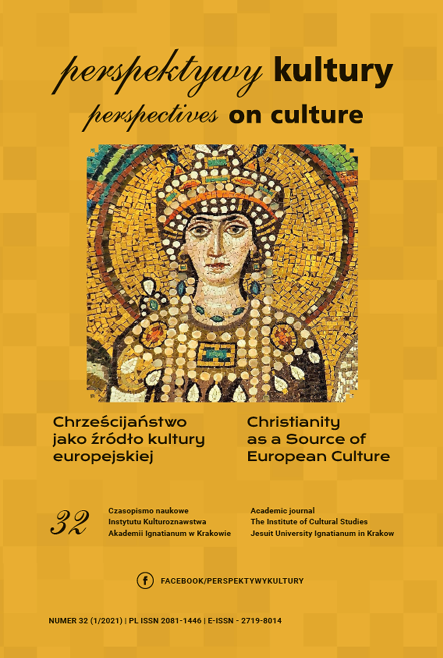Rola pieśni i piosenki religijnej w publicznych wystąpieniach Jana Pawła II podczas I pielgrzymki do Polski
Abstrakt
Celem artykułu jest zbadanie funkcji oraz okoliczności śpiewania pieśni i piosenek religijnych towarzyszących papieskim wystąpieniom podczas I pielgrzymki do Polski. Nie chodzi przy tym o muzyczną oprawę liturgii czy pieśni śpiewane np. podczas oczekiwania na rozpoczęcie spotkania z papieżem, ale o te, które były wykonywane w czasie tych wystąpień, czasami je przerywając, czasami uzupełniając. Pytanie badawcze brzmi: jaką rolę odgrywały pieśni i piosenki religijne w publicznych wystąpieniach Jana Pawła II podczas I pielgrzymki do Polski w czerwcu 1979 r.? Aby na nie odpowiedzieć, przeanalizowane zostały dostępne materiały wideo (https://jp2.tvp.pl) z tej pielgrzymki. Jako materiał badawczy posłużyły trzy homilie: homilia wygłoszona w Warszawie na pl. Zwycięstwa 2 czerwca 1979 r., homilia wygłoszona w Częstochowie 6 czerwca 1979 r. podczas mszy św. dla pielgrzymów z Górnego Śląska i Zagłębia Dąbrowskiego oraz homilia wygłoszona w Oświęcimiu 7 czerwca 1979 r., a także przemówienie na Wzgórzu Lecha w Gnieźnie z 3 czerwca 1979 r., przemówienie skierowane do młodzieży zebranej na krakowskiej Skałce z 8 czerwca 1979 r. i wreszcie rozmowy z młodymi zgromadzonymi pod oknem na ul. Franciszkańskiej 3.
Bibliografia
Cygański, A. (2018). Dialogiczny wymiar homilii po Soborze Watykańskim II. Kraków: Wydawnictwo Unum.
Jan Paweł II (2010). Pielgrzymki do ojczyzny. Przemówienia, homilie. Kraków: Znak.
Jankosz, M. (2018). Sytuacje komunikacyjne publicznych wystąpień Jana Pawła II podczas I pielgrzymki do Polski. Polonia Sacra, 50, 183–194.
Jankosz, M. & Przyczyna, W. (2020). Forma, język i styl homilii ojca Adama Szustaka, księdza Piotra Pawlukiewicza i arcybiskupa Grzegorza Rysia. Stylistyka, XXIX, 131–145.
Przyczyna, W. (2013). Homilia pięćdziesiąt lat po Soborze Watykańskim II. Pytania, problemy, wyzwania. Kraków: Wydawnictwo M.
Przyczyna, W. (2020). Pojęcie homilii i kazania. Ujęcie homiletycznoteologiczne. In W. Przyczyna & K. Skowronek (eds.), Język homilii i kazań. Tarnów: Wydawnictwo Biblos.
Przyczyna, W. & Skowronek, K. (2020). Wstęp. In W. Przyczyna i K. Skowronek (eds), Język homilii i kazań. Tarnów: Wydawnictwo Biblos.
Sieradzka-Mruk, A. (2009). Język kaznodziejski jako przykład polszczyzny mówionej (wybrane aspekty). In B. Dunaj & M. Rak (eds.), Polszczyzna mówiona ogólna i regionalna. Materiały ogólnopolskiej konferencji naukowej, Kraków 25–26 września 2008. Kraków, 357–364.
Wilkoń, A. (2000). Typologia odmian językowych współczesnej polszczyzny. Katowice: Wydawnictwo Uniwersytetu Śląskiego.
Woźniak, Z. (2015). Kilka uwag o języku współczesnych pieśni i piosenek religijnych. Colloquia Theologica Ottoniana, 1, 171–190.
Zdunkiewicz-Jedynak, D. (1996). Językowe środki perswazji w kazaniu. Kraków: Poligrafia Salezjańska.
Zerfass, R. (1995). Od aforyzmu do kazania. Kraków: Poligrafia Salezjańska.
Copyright (c) 2021 Akademia Ignatianum w Krakowie

Utwór dostępny jest na licencji Creative Commons Uznanie autorstwa – Bez utworów zależnych 4.0 Międzynarodowe.
Autor, zgłaszając swój artykuł, wyraża zgodę na korzystanie przez Wydawnictwo Uniwersystet Ignatianum z utworu na następujących polach eksploatacji:
- utrwalania utworu w formie papierowej, a także na nośniku cyfrowym lub magnetycznym;
- zwielokrotnienia utworu dowolną techniką, bez ograniczenia ilości wydań i liczby egzemplarzy;
- rozpowszechniania utworu i jego zwielokrotnionych egzemplarzy na jakimkolwiek nośniku, w tym wprowadzenia do obrotu, sprzedaży, użyczenia, najmu;
- wprowadzenia utworu do pamięci komputera;
- rozpowszechniania utworu w sieciach informatycznych, w tym w sieci Internet;
- publicznego wykonania, wystawienia, wyświetlenia, odtworzenia oraz nadawania i reemitowania, a także publicznego udostępniania utworu w taki sposób, aby każdy mógł mieć do niego dostęp w miejscu i czasie przez siebie wybranym.
Wydawca zobowiązuje się szanować osobiste prawa autorskie do utworu.





